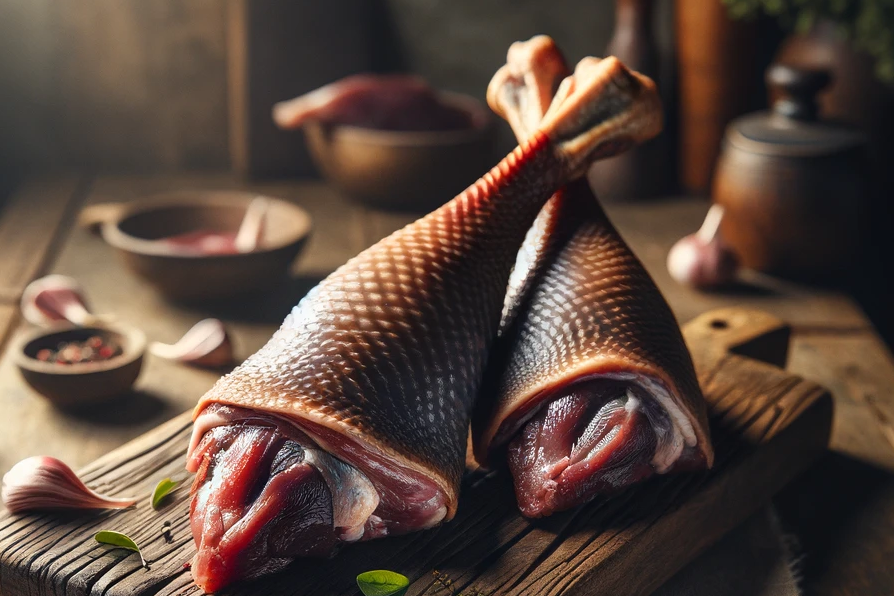Duck legs

With the abundance of dog foods available, pet owners are always looking for healthy and nutritious options to optimize their four-legged friends' diets. Duck thighs, often overlooked, could be one such tasty and nutritious addition. However, as with any ingredient, there are pros and cons to consider. This article dives deep into the topic of duck legs, highlighting their benefits to a dog's diet and discussing potential concerns.
What are duck legs?
Duck legs are the legs of the duck, a dark meat known for its rich flavor and juicy texture. Compared to breast meat, it contains more fat and connective tissue, making it an excellent source of energy and nutrients. For feeding dogs, duck legs are often cooked or dried to minimize potential health risks from raw meat.
Benefits of duck legs for dogs
High nutritional value
Duck legs are rich in protein, which is essential for building and maintaining muscle mass in dogs. They also provide important fatty acids, vitamins such as B vitamins, and minerals, including iron and zinc, which contribute to a healthy diet.
Energy source
The fat contained in duck legs is an excellent source of energy, especially important for active and working dogs that have a higher calorie requirement.
Promotion of dental health
Cooked or dried duck legs, when fed under supervision, can help to clean teeth. Chewing on the meaty bone helps to reduce plaque and massage the gums.
Acceptance
Many dogs prefer the rich flavor of duck meat. Duck legs can therefore be a welcome change in the diet and a motivation for picky eaters.
Disadvantages and risks
Bones
Although chewing on bones can have benefits for dental health, it also carries risks. Splintering bones can lead to internal injuries or blockages. It is essential to supervise dogs when chewing and avoid raw bones.
Fat content
The high fat content of duck legs can lead to weight gain and associated health problems if consumed in excess, especially in dogs that are prone to obesity.
Allergies
Although duck meat is often considered a hypoallergenic protein source, some dogs can be allergic to it. Symptoms may include skin problems, itching or indigestion.
Preparation
Proper preparation of duck legs is crucial to minimize health risks. Raw duck legs should be avoided to reduce the risk of salmonella or other pathogenic germs.
A delicious addition with moderation
Duck thighs can be a nutritious and tasty addition to your dog's diet when used responsibly. The benefits range from high nutritional value to promoting dental health, but the risks should not be overlooked. Careful preparation and consideration of individual health conditions and allergies are crucial to safely reap the benefits of duck thighs. As with any dietary change or supplement, it is advisable to speak to a vet beforehand. With the right balance, duck thighs can be a valuable and enjoyable component of your dog's diet.
If you notice any signs of hypersensitivity or poisoning in your dog, you should see your vet immediately. We are not a substitute for a vet, but we try to be as accurate as possible. Every dog reacts differently and we recommend you get a second opinion or consult your vet if in doubt.
Stay healthy and take good care of your four-legged friend!😊
Similar to Duck legs
Goose legs are the lower parts of the legs of a goose, which are rich in meat and are often prepared by roasting, braising or other cooking methods. They are known for their dark, juicy meat and...
Chicken thigh is a part of the chicken leg that consists of the thigh bone and the adjacent meat. Chicken thigh is rich in protein, iron, zinc and vitamin B12. It also contains fat, cholesterol and...
Pigeon legs, as the name suggests, come from the lower limbs of the pigeon. They are characterized by their dark, tender meat, which is a rich source of various nutrients. Unlike white poultry meat...
Turkey thighs come from the lower part of the legs of the turkey, a bird known for its tasty meat. These thighs consist of darker meat compared to the breast and contain both muscle and connective...


